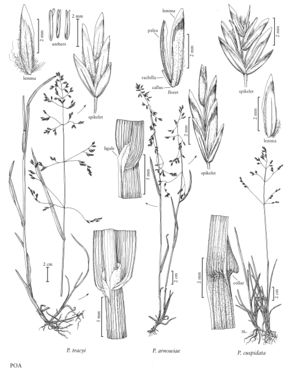Difference between revisions of "Poa cuspidata"
FNA>Volume Importer |
FNA>Volume Importer |
||
| Line 17: | Line 17: | ||
-->{{Treatment/Body | -->{{Treatment/Body | ||
|distribution=Md.;N.J.;W.Va.;Pa.;La.;Del.;Ala.;D.C;Tenn.;N.C.;S.C.;Va.;Ohio;Ga.;Ind.;N.Y.;Ky. | |distribution=Md.;N.J.;W.Va.;Pa.;La.;Del.;Ala.;D.C;Tenn.;N.C.;S.C.;Va.;Ohio;Ga.;Ind.;N.Y.;Ky. | ||
| − | |discussion=<p>Poa cuspidata is a common species of forest openings in the Appalachian Mountains. It is an eastern counterpart of P. arnowiae (see previous), P. tracyi (p. 543), and P. nervosa (see next). Like those species, it is sequentially gynomonoecious.</p> | + | |discussion=<p><i>Poa cuspidata</i> is a common species of forest openings in the Appalachian Mountains. It is an eastern counterpart of <i>P. arnowiae</i> (see previous), <i>P. tracyi</i> (p. 543), and <i>P. nervosa</i> (see next). Like those species, it is sequentially gynomonoecious.</p> |
|tables= | |tables= | ||
|references= | |references= | ||
| Line 26: | Line 26: | ||
-->{{#Taxon: | -->{{#Taxon: | ||
name=Poa cuspidata | name=Poa cuspidata | ||
| − | |||
|authority=Nutt. | |authority=Nutt. | ||
|rank=species | |rank=species | ||
| Line 34: | Line 33: | ||
|family=Poaceae | |family=Poaceae | ||
|illustrator=Sandy Long | |illustrator=Sandy Long | ||
| + | |illustration copyright=Utah State University | ||
|distribution=Md.;N.J.;W.Va.;Pa.;La.;Del.;Ala.;D.C;Tenn.;N.C.;S.C.;Va.;Ohio;Ga.;Ind.;N.Y.;Ky. | |distribution=Md.;N.J.;W.Va.;Pa.;La.;Del.;Ala.;D.C;Tenn.;N.C.;S.C.;Va.;Ohio;Ga.;Ind.;N.Y.;Ky. | ||
|reference=None | |reference=None | ||
| Line 39: | Line 39: | ||
|publication year= | |publication year= | ||
|special status= | |special status= | ||
| − | |source xml=https:// | + | |source xml=https://jpend@bitbucket.org/aafc-mbb/fna-data-curation.git/src/f50eec43f223ca0e34566be0b046453a0960e173/coarse_grained_fna_xml/V24/V24_763.xml |
|subfamily=Poaceae subfam. Pooideae | |subfamily=Poaceae subfam. Pooideae | ||
|tribe=Poaceae tribe Poeae | |tribe=Poaceae tribe Poeae | ||
Revision as of 20:24, 16 December 2019
Plants perennial; loosely tufted or with solitary shoots, shortly rhizomatous. Basal branching mainly extravaginal. Culms 15-60 cm, erect or the bases decumbent, not branching above the base, terete or weakly compressed; nodes terete, 0-1 exserted. Sheaths closed for about 1/2 their length, slightly compressed, distinctly keeled, glabrous, bases of basal sheaths glabrous, distal sheath lengths 4-60 times blade lengths; collars of proximal leaves usually retrorsely scabrous or pubescent distally and about the throat; ligules 0.5-4 mm, smooth or scabrous, apices truncate to acute; innovation blades similar to the cauline blades; cauline blades 1-4 mm wide, usually flat, sometimes slightly folded, smooth or sparsely scabrous, primarily over the veins, apices broadly prow-shaped, blades steeply reduced in length distally, flag leaf blades 0.2-3(6) cm. Panicles 5-15 cm, erect or lax, pyramidal, open, sparse, with 20-80 spikelets, proximal internodes usually 3+ cm; nodes usually with 2 branches; branches (2)3-7(10) cm, spreading to reflexed, straight, angled, angles scabrous, with 2-8(10) spikelets. Spikelets 5-8 mm, lengths to 3.5 times widths, laterally compressed, not sexually dimorphic; florets 2-5; rachilla internodes smooth. Glumes narrowly lanceolate to lanceolate, distinctly keeled; lower glumes 1-3-veined; calluses webbed, hairs over 1/3 the lemma length; lemmas 3-6 mm, lanceolate, distinctly keeled, keels and marginal veins sparsely short- to long-villous, lateral veins moderately prominent, intercostal regions glabrous or the upper florets in the spikelets softly puberulent, margins glabrous, apices acute; palea keels scabrous, softly puberulent at midlength; anthers vestigial (0.1-0.2 mm) or 2-3.5 mm. 2n = 28.
Distribution
Md., N.J., W.Va., Pa., La., Del., Ala., D.C, Tenn., N.C., S.C., Va., Ohio, Ga., Ind., N.Y., Ky.
Discussion
Poa cuspidata is a common species of forest openings in the Appalachian Mountains. It is an eastern counterpart of P. arnowiae (see previous), P. tracyi (p. 543), and P. nervosa (see next). Like those species, it is sequentially gynomonoecious.
Selected References
None.
